WordPress - Overview
WordPress is an open source Content Management System (CMS), which allows the users to build dynamic websites and blogs. WordPress is the most popular blogging system on the web and allows updating, customizing and managing the website from its back-end CMS and components.What is Content Management System (CMS)?
The Content Management System (CMS) is a software which stores all the data such as text, photos, music, documents, etc. and is made available on your website. It helps in editing, publishing and modifying the content of the website.WordPress was initially released on 27th May, 2003 by Matt Mullenweg and Mike Little. WordPress was announced as open source in October 2009.
Features
- User Management − It allows managing the user information such as changing the role of the users to (subscriber, contributor, author, editor or administrator), create or delete the user, change the password and user information. The main role of the user manager is Authentication.
- Media Management − It is the tool for managing the media files and folder, in which you can easily upload, organize and manage the media files on your website.
- Theme System − It allows modifying the site view and functionality. It includes images, stylesheet, template files and custom pages.
- Extend with Plugins − Several plugins are available which provides custom functions and features according to the users need.
- Search Engine Optimization − It provides several search engine optimization (SEO) tools which makes on-site SEO simple.
- Multilingual − It allows translating the entire content into the language preferred by the user.
- Importers − It allows importing data in the form of posts. It imports custom files, comments, post pages and tags.
Advantages
- It is an open source platform and available for free.
- CSS files can be modified according to the design as per users need.
- There are many plugins and templates available for free. Users can customize the various plugins as per their need.
- It is very easy to edit the content as it uses WYSIWYG editor (What You See Is What You Get is a user interface that allows the user to directly manipulate the layout of document without having a layout command).
- Media files can be uploaded easily and quickly.
- It offers several SEO tools which makes on-site SEO simple.
- Customization is easy according to the user's needs.
- It allows creating different roles for users for website such as admin, author, editor and contributor.
Disadvantages
- Using several plugins can make the website heavy to load and run.
- PHP knowledge is required to make modifications or changes in the WordPress website.
- Sometimes software needs to be updated to keep the WordPress up-to-date with the current browsers and mobile devices. Updating WordPress version leads to loss of data, so it a backup copy of the website is required.
- Modifying and formatting the graphic images and tables is difficult.
WordPress - Installation
System Requirements for WordPress
- Database − MySQL 5.0 +
- Web Server −
- WAMP (Windows)
- LAMP (Linux)
- XAMP (Multi-platform)
- MAMP (Macintosh)
- Operating System − Cross-platform
- Browser Support − IE (Internet Explorer 8+), Firefox, Google chrome, Safari, Opera
- PHP Compatibility − PHP 5.2+
Download WordPress
When you open the link https://wordpress.org/download/, you will get to see a screen as the following snapshot −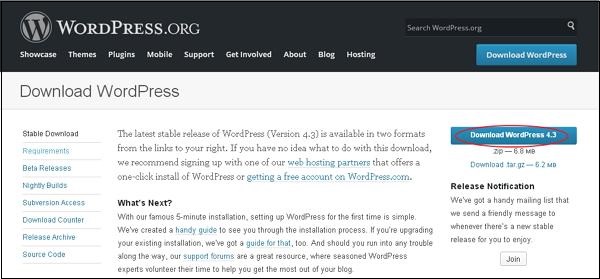
Create Store Database
- WordPress requires MySQL database. So create a new empty database with user/password (for example, user as "root" and password as "root" or else you can set as per your convenience).
- Then, you can continue with the installation process as discussed further.
Set Up Wizard
It's very easy to set up WordPress into your system. The following steps describe how to set up WordPress locally on your system.Step (1) − Extract the downloaded WordPress folder and upload it into your web server or localhost.
Step (2) − Open your browser and navigate to your WordPress file path, then you will get the first screen of the WordPress installer as shown in the following screen. In our case, the path is localhost/< Your_wordpress_folder >.
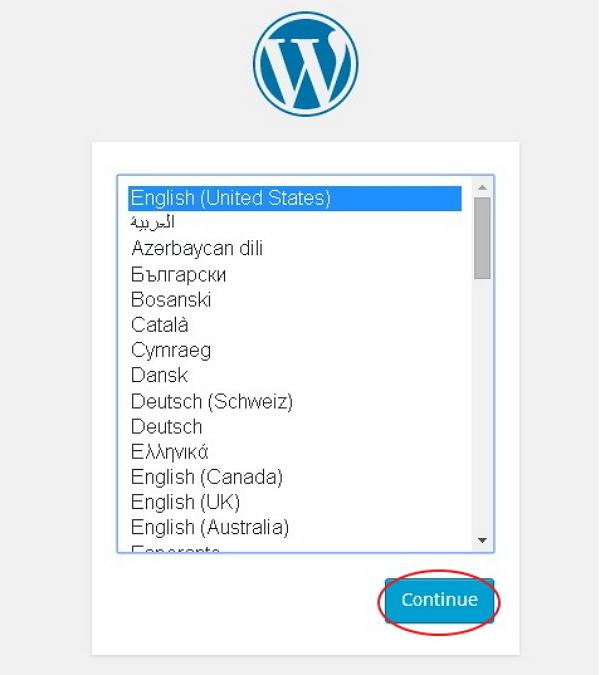 Select your language for the WordPress and click on Continue.
Select your language for the WordPress and click on Continue.Step (3) − In this step, you can view the information needed for the database before proceeding with WordPress installation.
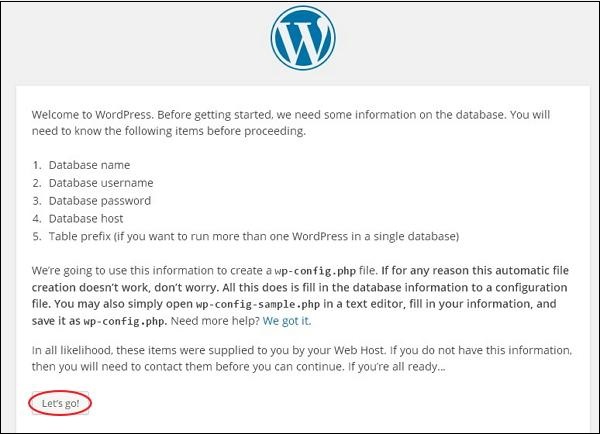 Click on Let's go!
Click on Let's go!Step (4) − Here, you have to enter the information about the MySQL database as described in the following screen.
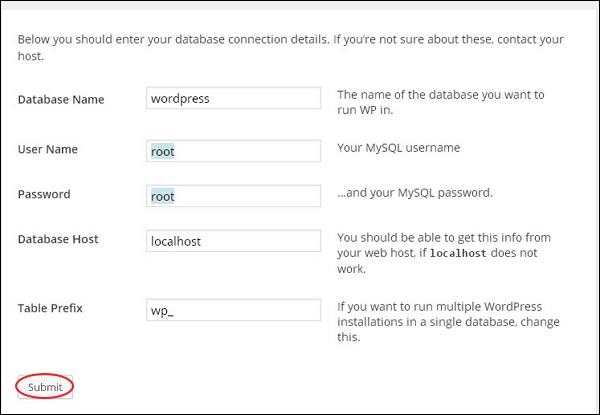
- Database Name − Enter the database name which you have created in MySQL database for WordPress.
- Username − Enter the user name of your MySQL database.
- Password − Enter the password which you had set for MySQL database.
- Database Host − Write the host name, by default it will be localhost.
- Table Prefix − It is used to add prefix in the database tables which helps to run multiple sites on the same database. It takes the default value.
Step (5) − WordPress checks the database setting and gives you the confirmation screen as shown in the following snapshot.
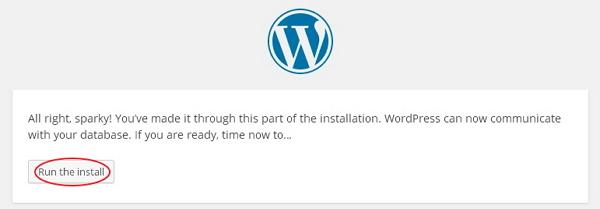 Click on Run the install
Click on Run the installStep (6) − Enter administrative information.
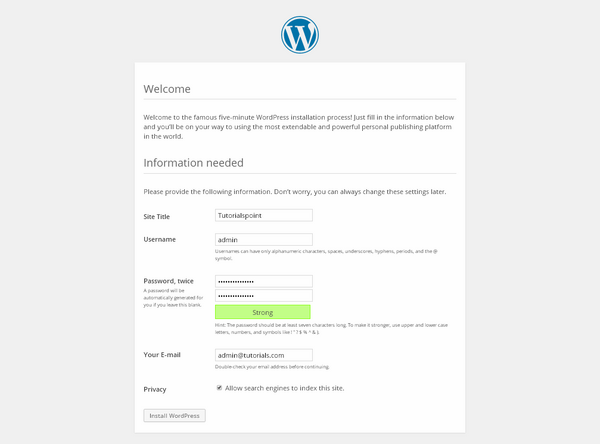 It contains the following fields −
It contains the following fields −- Site Title − Enter the name of the site which you are going to create in WordPress.
- Username − Enter the username as per your choice while logging in the WordPress.
- Password twice − Enter password two times to protect your site.
- Your E-mail − Enter your e-mail address which helps to recover the password or any update.
- Privacy − It allows the search engine to index this site after checking the checkbox.
Step (7) − After installation being successful, you will get a screen of the stating success as seen in the following screen.
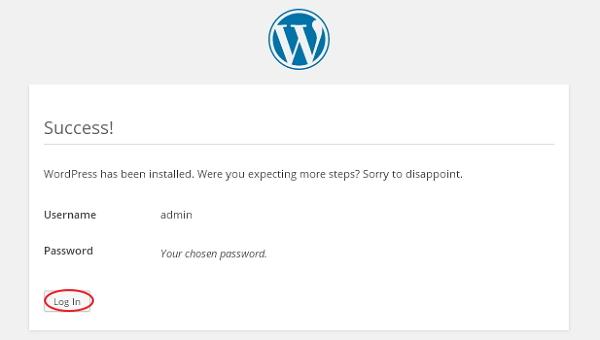 You can view your username and password detail added in WordPress.
You can view your username and password detail added in WordPress.Click on Log In button.
Step (8) − After clicking on login, you will get a WordPress Admin Panel as depicted in the following screen.
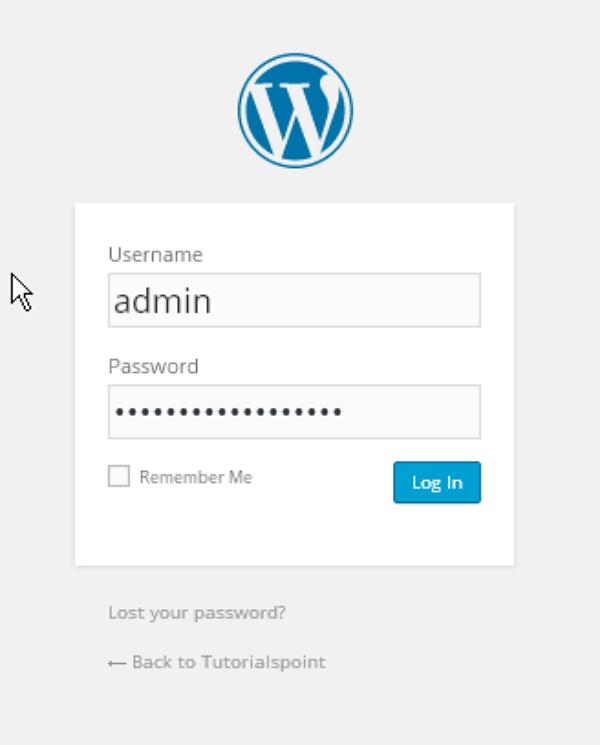 Enter the username and password which you had mentioned during installation as shown in step 6 and click on the Log In button.
Enter the username and password which you had mentioned during installation as shown in step 6 and click on the Log In button.WordPress - Dashboard
The WordPress Dashboard is a first screen which will be seen when you log into the administration area of your blog which will display the overview of the website. It is a collection of gadgets that provide information and provide an overview of what's happening with your blog. You can customize your needs by using some quick links such as writing quick draft, replying to latest comment, etc.Dashboard can be categorized as shown in the following snapshot. Each of these categories are discussed in the following sections −
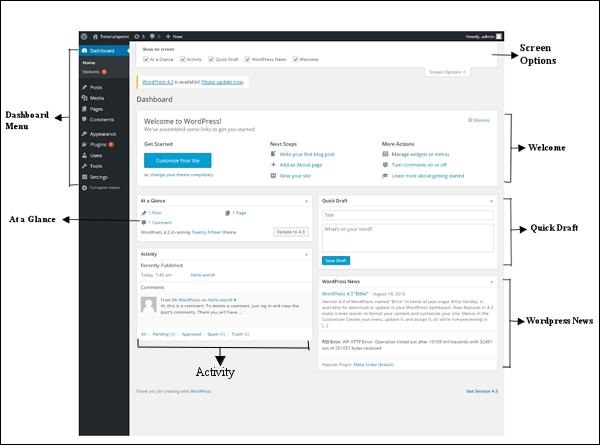
Dashboard Menu
The WordPress Dashboard provides navigation menu that contains some menu options such as posts, media library, pages, comments, appearance options, plugins, users, tools and settings on the left side.Screen Options
The dashboard contains different types of widgets which can be shown or hidden on some screens. It contains check boxes to show or hide screen options and also allows us to customize sections on the admin screen.Welcome
It includes the Customize Your Site button which allows customizing your WordPress theme. The center column provides some of the useful links such as creating a blog post, creating a page and view the front end of your website. Last column contains links to widgets, menus, settings related to comments and also a link to the First Steps With WordPress page in the WordPress codex.Quick Draft
The Quick Draft is a mini post editor which allows writing, saving and publishing a post from admin dashboard. It includes the title for the draft, some notes about the draft and save it as a Draft.WordPress News
The WordPress News widget displays the latest news such as latest software version, updates, alerts, news regarding the software etc. from the official WordPress blog.Activity
The Activity widget includes latest comments on your blog, recent posts and recently published posts. It allows you to approve, disapprove, reply, edit, or delete a comment. It also allows you to move a comment to spam.At a Glance
This section gives an overview of your blog's posts, number of published posts and pages, and number of comments. When you click on these links, you will be taken to the respective screen. It displays the current version of running WordPress along with the currently running theme on the site.WordPress - General Setting
In this chapter, we will study about General Settings in WordPress. WordPress general setting is used to set the basic configuration settings for your site. In the setting administration screen, it is a default setting screen.Following are the steps to access the general settings −
Step 1 − Click on Settings → General option in WordPress.
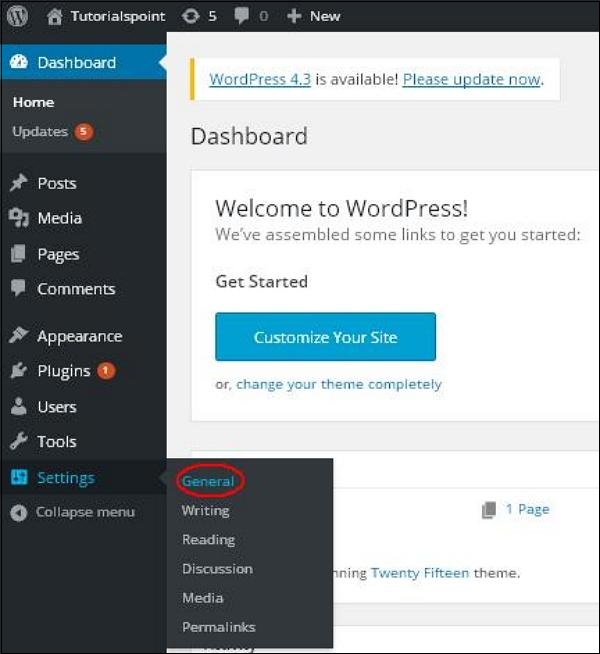 Step 2 − The General Setting page is displayed as shown in the following snapshot.
Step 2 − The General Setting page is displayed as shown in the following snapshot.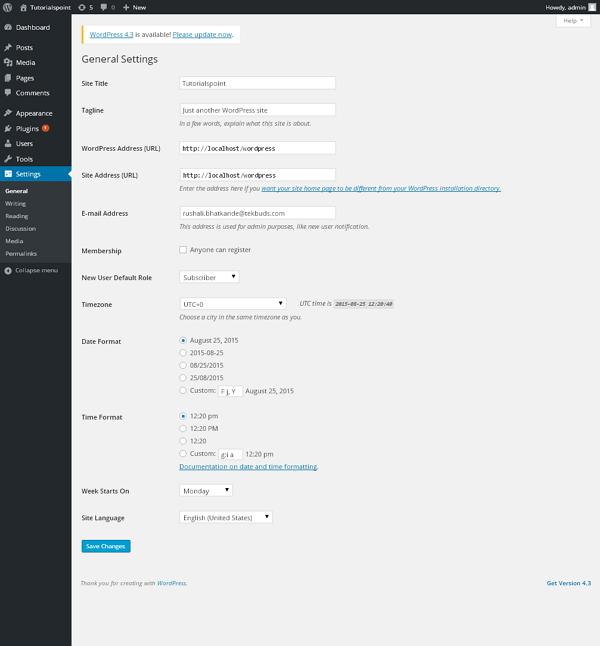 Following are the details of the fields on general settings page.
Following are the details of the fields on general settings page.- Site Title − It displays the name of the site in the template header.
- Tagline − Displays a short sentence about your site.
- WordPress Address (URL) − It is the URL of WordPress directory where your all core application files are present.
- Site Address(URL) − Enter the site URL which you want your site to display on the browser.
- E-mail Address − Enter your e-mail address which helps to recover your password or any update.
- Membership − Anyone can register an account on your site after you check this checkbox.
- New User Default Role − The default role is set for the newly registered user or members.
- Timezone − Sets the time zone based on the particular city.
- Date Format − Sets the date format as you need to display on the site.
- Time Format − Sets the time format as you need to display on the site.
- Week Starts On − Select the week day which you prefer to start for WordPress calendar. By default it is set as Monday.
- Site Language − Sets the language for the WordPress dashboard.
WordPress - Writing Setting
The writing settings controls the writing experience and provides options for customizing WordPress site. These settings control the features in the adding and editing posts, Pages, and Post Types, as well as the optional functions like Remote Publishing, Post via e-mail, and Update Services.Following are the steps to access the writing settings −
Step (1) − To change writing settings, go to Settings → Writing option.
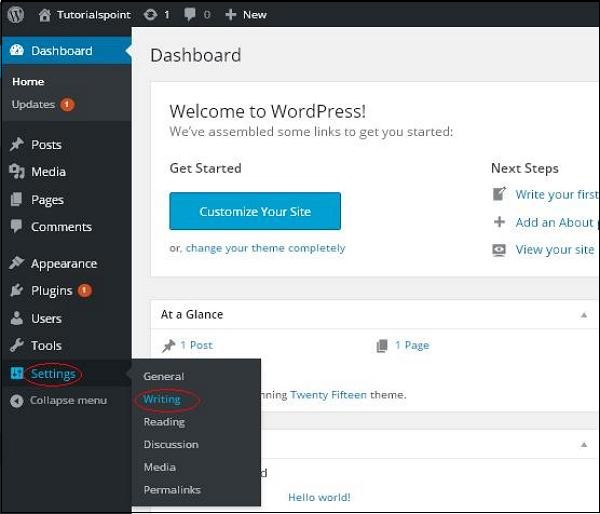 Step (2) − The Writing Setting page is displayed as shown in the following screen.
Step (2) − The Writing Setting page is displayed as shown in the following screen.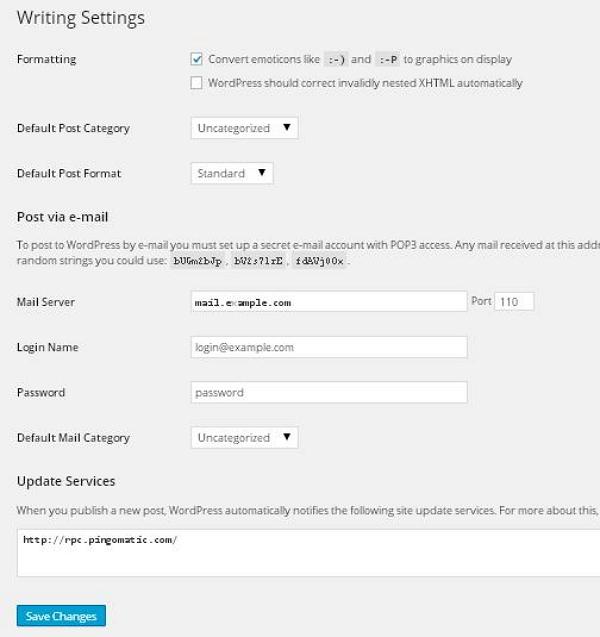 Following are the details of the fields on the page.
Following are the details of the fields on the page.- Formatting − This field defines two sub options for better user experience.
- The first option Convert emoticons like :-) and :-P to graphics on display will turn text-based emoticons into graphic-based emoticons.
- The second option WordPress should correct invalidly nested XHTML automatically corrects the invalid XHTML placed within the posts or pages.
- Default Post Category − It is a category to be applied to a post and you can leave it as Uncategorized.
- Default Post Format − It is used by themes to select post format to be applied to a post or create different styles for different types of posts.
- Post via e-mail − This option uses e-mail address to create posts and publishes posts on your blog through e-mail. To use this, you'll need to set up a secret e-mail account with a POP3 access, and any mail received at this address will be posted.
- Mail Server − It allows reading the e-mails that you send to WordPress and stores them for retrieval. For this, you need to have POP3 compatible mail server and it will have URI address such as mail.example.com, which you should enter here.
- Login Name − To create posts, WordPress will need its own e-mail account. The Login Name will use this e-mail address and should be kept as a secret as spammers will post links redirecting to their own websites.
- Password − Set password for the above e-mail address.
- Default Mail Category − It allows selecting custom category for all the posts that are published via Post by e-mail feature.
- Update Services − When you publish a new post, WordPress will automatically notify the site update services in the box. See the Update Services on the codex for the long list of possible services.

No comments:
Post a Comment